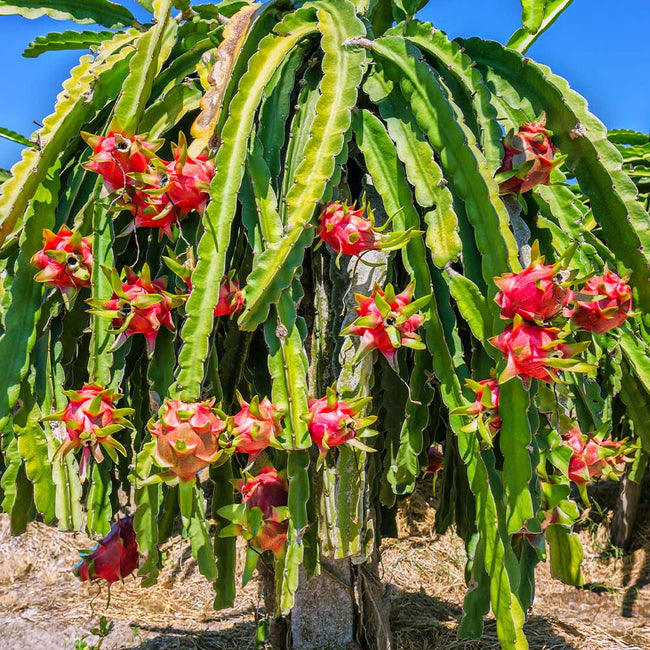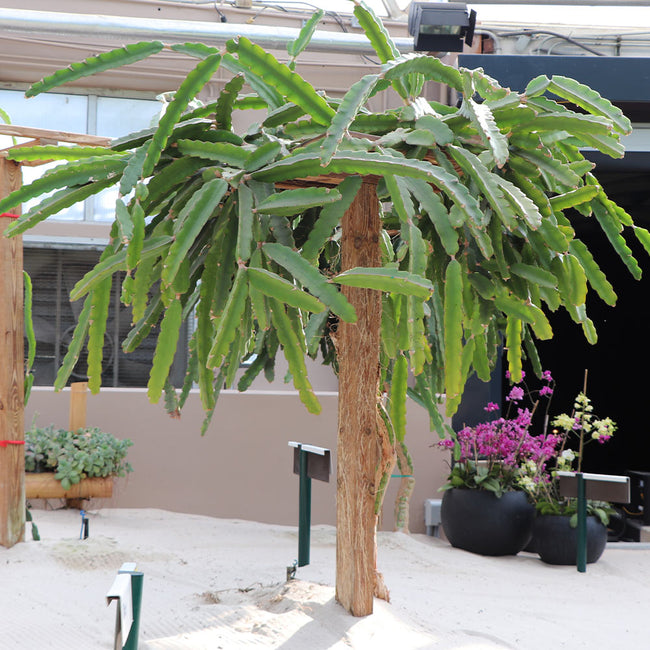* Images shown are of mature plants
My FGT Yard Planner
You'll need to log in or create an account in order to save this item

Have questions? Talk with our Plant Experts (800) 973-8959
A Cactus Tree with Delicious Tropical Fruit!
Here's why you should make this the year of the Dragon Fruit :
- Exotic cactus tree with versatile, tropical appeal
- Gorgeous, flaming-pink colored fruit
- Large white flowers with a sweet fragrance
- Climbing vine grows well in dry areas
Enter the Dragon Fruit Tree
Bring beauty and intrigue to your garden or landscape with the Dragon Fruit tree. A member of the cactus family, this incredible fruit tree is full of great surprises. For starters, the tree itself has an exotic appeal unlike any other. The palm-like trunk leads up to a twisty patchwork of cactus looking vines. This Southeast Asian-style tree would make an excellent specimen for an oriental garden or tropical motif.
Adding a burst of color are the large white blossoms that can grow to nearly a foot long. These lovely flowers are as fragrant as they are beautiful. But the real prize is the Dragon Fruit itself. Everything about the fruit is wonderfully different. From its elliptical shape to its striking neon-pink color, the Dragon is a jaw dropping standout in the landscape. In fact, we can't think of any other fruit that's more visually appealing than this one.
Dragon Fruit Smoothie, anyone?
Perhaps the only thing more interesting than the Dragon Fruit's looks is the way it tastes. Easily peel away the pink outer skin and inside you'll find a milky white flesh speckled with tiny black seeds similar to those of a kiwi, adding a crunchy texture to its juicy pulp. Similar to a cross between a melon and a pear, the sweet yet slightly sour taste is delicious, especially when eaten chilled.
Use Dragon Fruit to make a homemade sorbet, smoothie or tropical drink that will refresh and satisfy any summer thirst. It's also a savory ingredient when used in jellies, jams--even sauces. Not only does the Dragon Fruit offer a diversity of useful options in the kitchen, it's also said to be one of the healthiest fruits on earth.
Don't delay. Let the Dragon Fruit work its magic in your garden.
Pollination Info
Dragon Fruit Cactus Pollination
Dragon Fruit Cactuss are self-fertile. You will get fruit with only one plant. However, adding an additional Dragon Fruit Cactus will drastically increase the size of your crop.
Planting & Care
Dragon fruit, also called "pitaya" or "pitahaya," is the vibrant-colored and sweet-tasting fruit of cactus plants. It is relatively easy to grow, particularly for those in tropical or subtropical locations where maintenance is minimal. It can also be container-grown for those in frost-prone regions.
Choosing a location: A full sun location is best. When planting outside, expect the plant to go dormant while acclimating to its new environment. Dragon fruit cactus enjoy a lot of light so try to avoid shady areas. They also prefer a well draining soil, a sandy cactus potting mix (if container grown) works well. Remember, try to stay away from wet, mucky soils. If living in more temperate growing zones the dragon fruit can be potted and brought indoors, they adapt quite well.
Planting Instructions:Take your time when opening the shipping box. Most damage occurs when the box is ripped open in the excitement of receiving new plants. Many succulents are very fragile and sections will snap off easily if not handled carefully. Remove the plant from its pot by laying it on its side and lightly tapping the sides of the container. Gently slide the plant out of the pot. In some cases where the roots have grown through the holes of the container you may need to cut the container off of the plant.
Use a pair of garden shears or sharp knife to make slits down the sides of the root ball. This will encourage accelerated root growth into the new soil. Be sure not to cut too deeply into the main root system, the object is to only score or cut through the secondary (or feeder) roots.
1) Dragon fruit is a climbing cactus and will require support to climb on as it matures. Aerial roots that form on the ends of the branches seek out something to climb, so you will want to provide some long term support. A singular "climbing pole" will assist in giving the cactus structure and help it to reach its full potential without breaking off the lower sections of growth. For potted dragon fruit, you will need a similar support pole.
2) Plant in ground or in a container using well drained, sandy soil. Your dragon fruit cactus should be planted flush with the soil line. Often we have found mixing a small amount of slow, time release fertilizer into the lower level of the soil before planting speeds up the rate of growth. When planting in ground, space plants to allow clumps to form and develop properly. If planted too tightly there will not be enough room for root expansion and plants will not reach their full height and fruiting potential.
*Tip: For a potted dragon fruit cactus, allow enough room for root growth. A 10+ inch deep container will be good to start out and will do well with a climbing pole.
Watering: Dragon fruit cactus must be treated like a tropical cactus and watered when nearly dry. An automatic dripper at the top of the post works well. The leading cause of early death with cactus plants (and many others) is overwatering. Many decorative containers do not have drainage holes at the bottom. When a plant is regularly watered, the roots in the bottom of the pot are subjected to waterlogging at which point root decay begins. Keep this in mind when shopping for the cactus pot.
Pruning: Every few months, examine the cactus for areas of congested growth when it is actively growing. Be cautious when pruning, wear long sleeved shirts, gloves and pants. Prune off branches of the cactus that may be touching, growing over one another or touching the ground. You'll want clear areas around remaining branches so the large flowers that bloom at night have plenty of room to expand. This will also make the fruit much easier to pick.
*Tip: Feel free to discard what you removed or you can attempt to root them to create new cactus plants!
Fertilizing: Fertilizer can be detrimental to a dragon fruit cactus and too much can kill the plant. Fertilize sparingly with low-nitrogen cactus fertilizer, slow time release is best. For in ground planting, broadcast a balanced granular fertilizer once a month. Dragon fruit cactus are light feeders, however if left unfertilized, they will tend to grow very slowly and remain virtually dormant. For a rich, full look, feed them every other month but take care not to over fertilize.
Harvesting: Roughly 30 to 50 days after flowering is when the fruit should be about ready for harvesting. It will change from a bright green to a red or pink color. The fruit will be oval shaped and about 10-15 cm long. A few spots on the outer skin is normal but if it has a lot of dark splotches (similar to apple bruising) it may have become over ripened. The "wings" can also be a hint that the fruit is ripe or not. The wings are the leafier parts that extend off of the fruit. They will start to turn slightly brown and dry out. This means they are ready to be picked. If the wings are still a colorful yellow or red color, the fruit is still not quite fully ripened.
Propagating: One of the best benefits of having your own dragon fruit cactus is the ability to harvest the seeds from the fresh fruit and use them for more cactus plants.
1) Scoop out a pulpy seeded portion of the ripened fruit and wash all of the pulp off of the seeds.
2) Fill some very well draining pots with a sterile, germinating potting medium. You can purchase the medium or make it yourself using equal parts of sand, peat moss, vermiculite or perlite. Sow the seeds over the surface of the medium evenly.
3) Just barely cover the seeds by sprinkling a light layer of germinating medium over them.
4) Gently (but thoroughly) mist the medium and seeds at the time of sowing and when the medium is dry to the touch before germination.
5) Cover the pot with a plastic lid or glass to help maintain a level of high humidity around the seeds and cut back on the need to constantly mist. You can also enclose the pot in a plastic bag to assist with the humidity.
6) Place the seeded container in a place that receives bright but indirect light. Try to keep the temperature between 65 to 70 degrees for the best results. The seeds should germinate within 14 to 28 days and this is when you will remove the glass or plastic covering the pot and allow the surface to dry out a little between waterings.
Related Resources
Dragon Fruit Cactus Planting & Care
The Dragon Fruit, also called “pitaya,” is an exciting and delicious addition to any landscape. Known for its flaming pink fruit with white speckled flesh, ...
Read the full article
Video: Dragon Fruit Cactus
Our Dragon Fruit Cactus is an exotic cactus with versatile, tropical appeal. Follow along as our Plant Expert, Meredith, walks us through its delectable, neon ...
Read the full article
FAQs
How long does dragon fruit take to grow?
Is dragon fruit easy to grow?
Can we grow dragon fruit at home?
Shipping Details
Estimated Shipping Time: Most orders ship immediately. As noted on the website, some items are seasonal, and may only ship in spring or fall. Once your order is shipped, you'll receive an email with a tracking number.
| Amount of Order | Shipping Charge |
|---|---|
| Less than $129 | $19.95 |
| $129 + | FREE SHIPPING! |
Product Details
| Mature Height: | 5-10 ft. |
| Mature Width: | 10 ft. |
| Sunlight: | Full Sun |
| Growth Rate: | Fast |
| Harvest Time: | May - July |
| Year to Bear: | Can Fruit the 1st year! |
| Botanical Name: | Hylocereus undatus |
| Does Not Ship To: | AZ |
| Grows Well In Zones: | 4-11 patio / 9-11 outdoors |
| Your Growing Zone: | # |

Growing Zones: 4-11 patio / 9-11 outdoors
(hardy down to 30℉)Customer Reviews & Photos
- Reviews
- Questions
- plant
- cactus
- fruit
- shipping
- dragon fruit
- condition
- growth
- trees
- shape
- Fedex
Dragon Fruit Cactus
It arrived healthy.
Dragon fruit tree
Very nice I love it very healthy good package
Dragon Fruit
The cactus is alive, growing well, and quite healthy.












